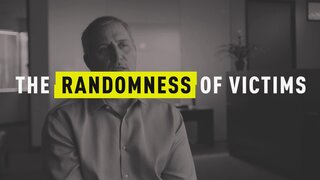Create a free profile to get unlimited access to exclusive videos, breaking news, sweepstakes, and more!
Israel Keyes May Have Tried To Biohack Himself So He Would Become A More Efficient Killer
Israel Keyes may have been trying to turn himself into the perfect murderer, Maureen Callahan, author of "American Predator: The Hunt for the Most Meticulous Serial Killer of the 21st Century," theorizes.
What's known about Israel Keyes is enough to send a shudder down anyone's spine: The Alaskan man murdered 11 people across the United States between 2001 and 2012. A meticulous serial killer who constantly morphed his modus operandi and the location in which he killed, Keyes managed to evade capture for years. But there's an even more terrifying possible aspect to the methodical serial killer: He may have been trying to transform himself into the apex predator.
Only three of the 11 people Keyes confessed to killing have been identified: Samantha Koenig in Alaska and Bill and Lorraine Currier, a couple from Vermont, according to the FBI. But Keyes has hinted that that’s a lowball number, and many experts, like Maureen Callahan, author of “American Predator: The Hunt for the Most Meticulous Serial Killer of the 21st Century,” believe he may have killed many, many more.
Why? Because Keyes enjoyed killing — in fact, Callahan even believes he enjoyed it so much he may have gone under the knife so he could kill more efficiently.
In her book, Callahan noted that Keyes went to Mexico often and that during some of his trips, he was getting surgery for something. Or, some things, to be more specific.
On May 12, 2006, he wrote, “Travel to surgery,” for an unspecified procedure in one of his journal entries.
Nearly a year later, on April 24, 2007, he wrote in his journal, “Travel to SD for dental work and medical lap band fill.”
Callahan noted that the gastric band surgery, if it is in fact what Keyes had, was particularly strange.
“Keyes was a tall, rangy guy, always had been. Aside from his military record, investigators learned he had also been a marathoner,” she wrote in her book.
Which, Callahan wrote, begs the question: “Why was a lean, strong athlete, then just twenty-eight years old, getting elective surgery to limit his food intake?”
She doesn’t think it was to lose weight. Instead, she theorizes he did it so he could gain time while killing without the pesky distraction of hunger.
“If you’re an apex predator, which he is, and all you want to do in life is hunt and kill human prey, why be distracted by crass, crude biological urges such as hunger? Why not circumvent that biological necessity?” she asked John Thrasher and Daryn Carp on an episode of Oxygen Media's podcast “Martinis and Murder.”
If so, she theorizes that gastric bypass surgery isn’t the only way he tried to biohack himself. Keyes had several plastic surgery appointments over the years.
She noted that he may have gotten a nose job, sure, based on some photos taken of him over the course of his life, but she is more interested in possible procedures that were a bit more diabolical in nature.
“Fingerprints can be surgically modified. Body hair can be lasered off. Perspiration can be short-circuited with Botox,” she wrote in her book.
Callahan noted that Keyes was pretty anxious about leaving DNA from sweat at crime scenes.
And the idea of biohacking using those kinds of methods isn't just a paranoid theory: People have done this before. Botox has been praised online for virtually ending sweating, with one woman writing for SELF about how she tossed her deodorant in the trash after getting Botox treatments.
As for the idea of modifying one's prints, a Chinese criminal apparently hired a plastic surgeon to surgically alter her fingerprints so she could avoid being detected and detained, ABC News reported in 2009. The surgeon removed parts of skin from her fingertips, and then grafted them onto other fingers to change her prints up. It worked for a while. She wasn’t detected when she snuck into Japan after being deported the first time around. The FBI even cautioned police to be aware of this trend back in 2015.
“There’s a lot you can do and I think he was so diabolical and I think he was so interested into turning himself into something like the FBI and the world had never seen that biohacking would be totally up his alley,” Callahan told Thrasher and Carp.
Besides, Keyes was already focused on making himself untraceable: He’d kill from state to state, typically far from home, abducting strangers who were as different as could be from one another. He had no type, no victim profile. He’d kill old people, young people, women, couples.
For that reason, he had a modus operandi that the FBI had never encountered before and one “that the FBI's top criminal minds openly admitted they could not understand,” Callahan said on “Martinis and Murder.”
There are theories out there that maybe the surgeries were for someone other than Keyes, but Callahan doesn’t think so.
“There was no reason to believe these entries were about anyone else,” she wrote. “The Keyes family didn’t believe in doctors or medicine. Israel himself had no close friends.”
Callahan doesn’t think that Keyes was accompanying his girlfriend to any surgeries either.
“I’ve heard the theory that these are elective surgeries that his girlfriend was having,” she said on “Martinis and Murder.” "I'd like to say I do not believe that is remotely possible. His girlfriend was a highly educated, well-compensated, traveled nurse who at the time of his arrest was working in the hospital in Anchorage. If she’s getting surgery, it’s in the United States. She’s not hot footing it to Tijuana to some shack to have someone carve her open.”
Callahan said the surgeries were something that Keyes kept close to him, just another one of his many creepy secrets.
Whether or not he was actually trying to biohack himself into a killing machine, we may never really know, as Keyes died by suicide in 2012 while awaiting trial for some of his crimes — but it's certainly a haunting idea, one that is very, very possible.






























